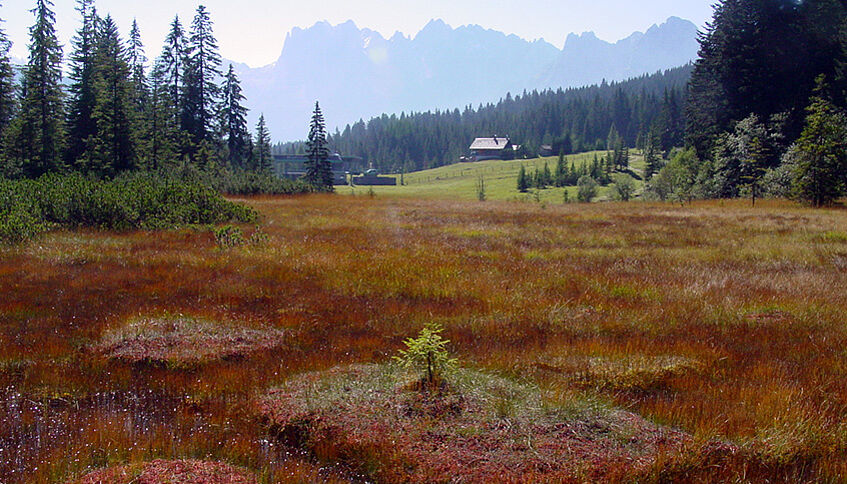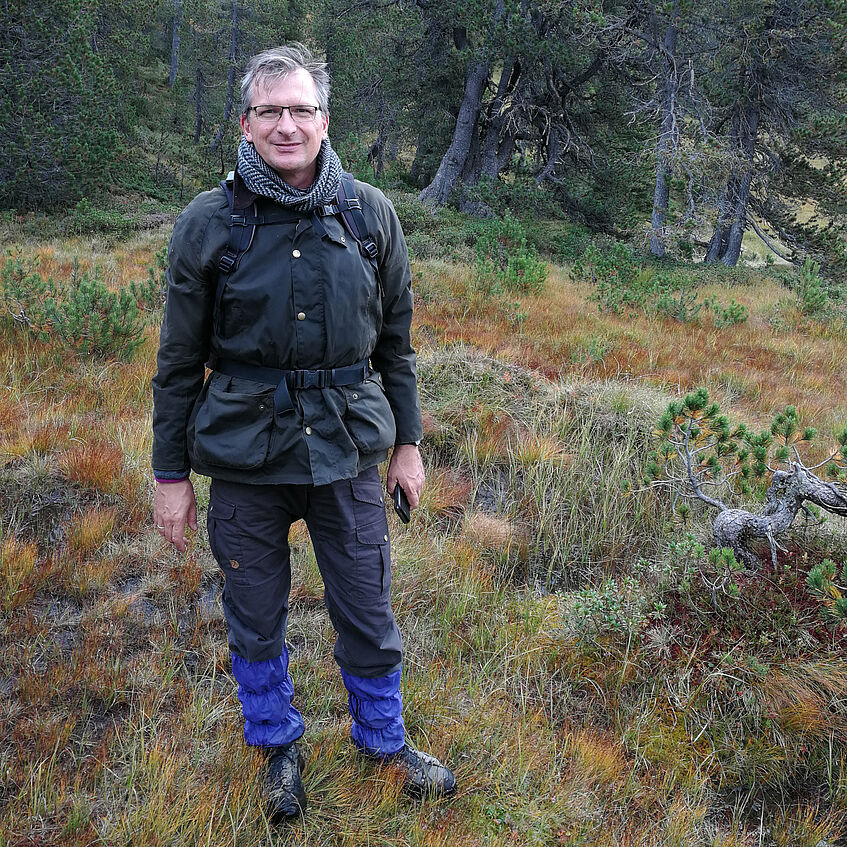
The AMooRe joint project involving the federal and state governments and the scientific community is co-financed by the EU's LIFE funding programme. (c) Gert Michael Steiner

Stephan Glatzel from the Department of Geography and Regional Research at the University of Vienna is involved in the project. (c) Stephan Glatzel
LIFE AMooRe - Austrian Moor Restauration
Austria has around 30,000 hectares of peatlands, but the conservation status of these areas is concerning. This critical situation requires substantial changes at many levels. In response to this, the Austrian Mire Strategy 2030+ was drawn up, in which all necessary fields of action for long-term mire protection in Austria were developed in a broad participatory process.
The LIFE AMooRe project aims to initiate the implementation of the mire strategy and thus enable comprehensive peatland protection in Austria. Only an intact peatland can fulfil its diverse ecosystem functions. These areas are not only important for climate protection by storing carbon, but also make a significant contribution to climate change adaptation.
The joint federal, state and scientific project is co-financed by the EU LIFE funding programme. More than 44 million euros are to be invested in peatland protection over the next ten years.
The focus of the Geoecology working group at the University of Vienna (S. Glatzel) within the large-scale project is in particular on researching the emission factors for carbon storage and the release of greenhouse gases from near-natural and disturbed peatlands as well as from agricultural and forestry land on peat soils. These emission factors describe the climate relevance of the respective land use type and the renaturalisation measures undertaken.
The Project
LIFE AMooRe aims to develop the key mechanisms together with all those directly and indirectly affected on the basis of good practice projects. The project thus combines strategic and practical measures. The protection of peatlands and peat soils is primarily the responsibility of the federal states, but many processes take place at a more comprehensive level. It is therefore important to establish interfaces between all levels or to expand existing ones. Priorities for action must be defined and long-term financing models developed.
Existing contradictions at administrative level should be resolved and peatland and peat soil protection should be given greater consideration in line with its social relevance. As the focus to date has been on the rewetting of raised bogs, there are knowledge deficits (e.g. fens) that need to be specifically addressed. The aim is to professionalise applied peatland protection in Austria by pooling specialist knowledge and using the numerous, broad-based implementation projects.
Selected measures
- Governance: Exchange and integration of the specialist areas of nature conservation, agriculture and forestry, commercial horticulture, water management, climate policy, spatial planning and tourism as well as the development of jointly viable solutions and recommendations for action on specific issues in peatland protection
- Building knowledge by developing a basis for action for peatland protection and transferring knowledge to implementers
- Implementation through good practice projects in around 40 peatland areas in Austria covering an area of approx. 1,400 ha, of which approx. 1,165 ha are favoured areas with 13 different habitat types and 37 species of high nature conservation value
- Monitoring of the implementation projects and the realisation of the mire strategy
- Project-related public relations work and networking
Project partners
- Project management: Office of the Vorarlberg Provincial Government - Department of Environmental and Climate Protection
- Project partners: 13 in total
- Federal Ministry of Agriculture, Forestry, Regions and Water Management (BML), Department I/6 - Flood Risk Management
- Federal Ministry for Climate Protection, Environment, Energy, Mobility, Innovation and Technology (BMK), Department V/10 - National Parks, Nature and Species Conservation
- Office of the Provincial Government of Lower Austria, Nature Conservation Department
- Office of the Upper Austrian Provincial Government, Nature Conservation Department
- Office of the Salzburg Provincial Government, Department of Nature Conservation and Environmental Protection
- Office of the Styrian Provincial Government, Department of Environmental and Spatial Planning
- Office of the Tyrolean Provincial Government, Department of Environmental Protection
- Office of the Vorarlberg Provincial Government, Department of Environmental and Climate Protection
- University of Vienna (AG Geoecology, S. Glatzel)
- Christian-Albrechts-University Kiel
- 3 associated partners: City of Vienna, Office of the Burgenland Provincial Government and Office of the Carinthian Provincial Government
- Project duration: 10 years (1 January 2024 - 31 December 2033)
- Total project costs: 44.23 million euros (60% of which is EU funding)
- EU funding programme: LIFE, Nature and Biodiversity sub-programme
- Project number: LIFE22-IPN-AT-LIFE AMooRe (101104368)
